|
Introduction
The
extent to
which vital security forces throughout the world are placing confidence
in the
radiotelephone for essential communication links is demonstrated by the
Denmark State Police
nation-wide radiotelephone
scheme installed by Pye Telecommunications Ltd starting in 1965.
This scheme, which puts every one of 1000
mobile units under radio control from its base no matter where it may
be
operating in the country, constitutes one of the largest export orders
ever
placed for Police radio equipment.
Organisation
Denmark
has 72 local Police centres each with its own
fleet of radio-controlled vehicles. These
local centres are grouped in five regions,
each directed by a
regional control.
The
Pye VHF radio scheme provides communication, (a) between mobiles and
their
local centres, (b) between mobiles
and
regional controls and (c) between local centres. (In most
cases, the
regional control also incorporates the local radio station for that
district).
Regional
Coverage
Each
regional control exercises radio coverage over an
area of
the order of 150 kilometres in diameter (sometimes
considerably more). The map shows how
this is attained by carefully siting up to four transmitting/receiving
stations
within the region, all operated remotely over land lines from the
regional
control centre.
A
novel receiver 'voting' system prevents
confusion which could
result from
speech signals being received at the control centre from two or
more
receivers at the same time. The voting
circuits select and pass only
the best
signal being received at any one time, completely muting the
remainder.
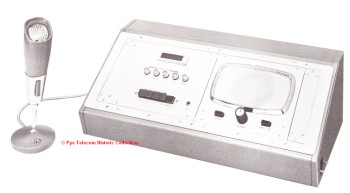
Typical Denmark Police regional control
console
Lamp
indicators on the control console show which receivers
are picking up the signal and also which of the receivers is
being
voted. In replying, the controller
selects the transmitter which will
best
cover the area of the receiver concerned.
Channels
Nine
channels are used in the system - seven of them two-frequency channels
and the
other are two single-frequency. Simplex
operation
(one way transmission at a time) is the only mode of operation
provided.
The channels are designated as follows:-
Channel
Purpose
1.
Local
channel - mobiles to their local centres
2.
As channel 1,
operating in Copenhagen only
3.
Car-telephone
service - Copenhagen
only
4.
Car-telephone
service - Copenhagen
only
5.
Regional
controls to
mobiles
6.
Nation-wide mobile
channel
7.
Reserved for
special services
8.
Reserved for
special service
The
frequency range covered by the whole system is less than 1 MHz.
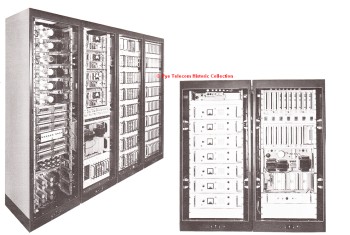
About
one quarter of the Copenhagen equipment racks
Equipment
All
the equipment is of special design. The
mobile units, each of them capable of operating anywhere in the
country, are
8-channel FM 'Cambridge'
equipments. They are all of the 'Universal'
type (i.e. providing for remote control of the transmitter receiver
unit). Channel spacing is 25kHz throughout. All mobile
equipment is ruggedized and
weatherproof, with full compatibility for use either in vehicles or on
motor
cycles. They will all operate from 6 or
12 volt dc supplies.
Fixed
stations use 50-watt FM transmitters and fully transistorised, highly
sensitive
receivers. All control stations, both
local and regional, operate their radiotelephones over land-lines from
console-type remote control desks at the control centre.
|
These
are built up from individual modules
using the customary Pye Telecom 'building-brick' method. The
control functions selected at the control
console send coded pulse
trains along the line to the radio equipment. Here
they operate Ledex electro-mechanical switching elements
which adjust the
controls accordingly.
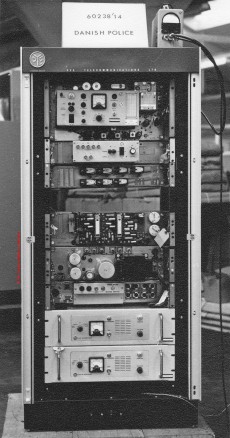
Typical Denmark Police transmitter-receiver
rack
The
Copenhagen
centre is unique. It combines the functions of a large and
sophisticated local
centre for the city with those of a regional control for a very wide
area - the
largest region, in fact, in the country.
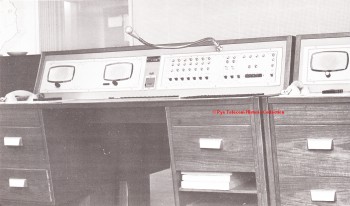
Copenhagen Operators console
The
very wide regional coverage from Copenhagen
is effected from five transmitting/receiving sites at strategic points
in the
region. Four of these have receiver
voting and one
is in an area where voting facilities are not required.
Additional
stations provide the local (city area) coverage; two transmitter sites,
which
between them cover all eight channels, with standby facilities, and
four
receiving sites each with a receiver for each channel. Thus four
voted receivers cover each channel.
All
control functions at Copenhagen,
both local and regional, are centered in a supervisor's console.
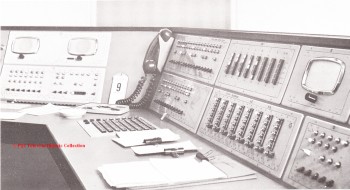
Copenhagen Supervisors console
The
supervisor allocates the channels, at
will, to five operators. A tone squelch
system protects the network against interference by or with other
systems (in
neighbouring countries, for instance) using the same frequencies.
The transmitted signal carries, in addition
to the speech intelligence, a sub-audio modulation which is separated
at the
receiver and used to lift the squelch muting. In
the absence of the sub-audio component the
receiver remains muted.
The
voting equipment includes cold-cathode switching and pulse generating
equipment. Received signals give rise to
trains of digital pulses, the repetition rates of which vary according
to the
quality of the signal. The better the
signal the higher the pulse repetition rate. The
'voting' circuits select the receiver having the
signal producing the
highest pulse rate and present an indication of the receiver selected
to the
control operator.
|